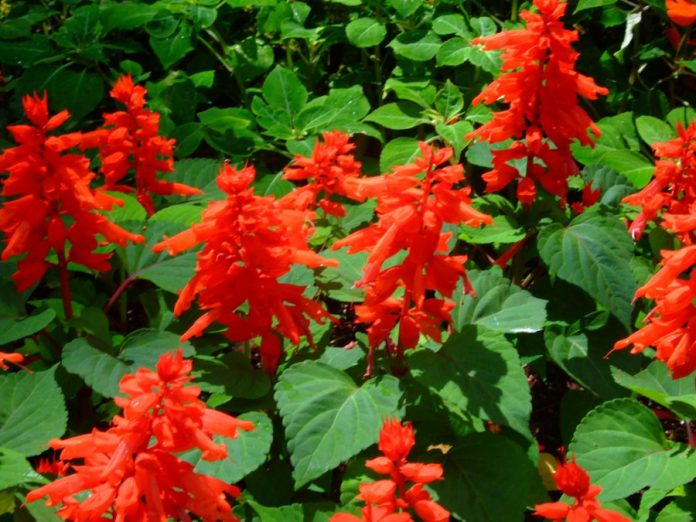
Salvias, which appear in the stores in annual and perennial varieties, are sages that belong to the mint plant family.
The vivacious compact annual known as Scarlet Sage (Salvia splendens) is readily available for purchase in the spring. It struggles in Texas summer heat, whereas its perennial sisters– the Pineapple Sage (Salvia elegans), Autumn or Cherry Sage (Salvia greggii) and Mealy Cup Sage (Salvia farinacea)– thrive in hot weather, then come back year-after-year into the bargain.
Salvia stems contain dormant or sleeping root cells that grow rapidly when the stem comes into contact with moist soil. In other words, you can bend a length of salvia stem against damp soil, hold it in place with a piece of old brick or the like, water and, in a month or so, the stem will grow roots. In time, you may separate the newly-rooted stem from its parent plant and, voilà, there are two plants instead of one.
Grown for their durability, the most common salvias in local gardens are the S. greggii varieties. Averaging 24- to 30-inches tall and wide, the red, crimson, pink, salmon, white and vari-colored flowers bloom on woody stems from late spring until Jack Frost imposes dormancy. Many gardeners like to control them with an August “haircut,” which also produces a new flush of flowers.
The fresh cuttings drinking in a bucket of clean water can be propagated following these six easy steps:
1– Fill a clean, sterile six-inch pot with rooting mix from the nursery. Rooting mix is not potting mix. Ask the nurseryman for the right medium. Wet the mix then use a pencil to make eight planting holes around the pot;
2– Cut a new three- to four-inch shoot off a healthy stem. Take care to cut a piece of the parent stem tissue along with the shoot;
3– Remove lower leaves from the cut stem so there is two-inches of bare stem between the remaining leaves and the bump or node, where the stem is attached to the piece of its parent tissue;
4– Brush rooting hormone powder on the stem part to be planted, then insert it into the planting hole and tamp the soil around it;
5– Fill all the holes with prepared cuttings, then put the pot in a one-gallon, clear plastic, closable bag. This “tent” will provide humidity for the cuttings during root growth. Keep the cuttings out of direct sunlight. They don’t mind a shop- or grow-light during the day. In about four weeks each cutting should have good roots; and,
6– Gently tease the new plants apart and repot each in a three-inch container of well-dampened potting soil (that contains fertilizer). Grow in the small pots for six- to eight-weeks before planting outside or potting up for a winter in the greenhouse.
Perennial salvias left outdoors die back to the ground in the winter. Cut off the dead growth, give the plant a drink now and then and new growth will reappear when things warm up in the spring.

















